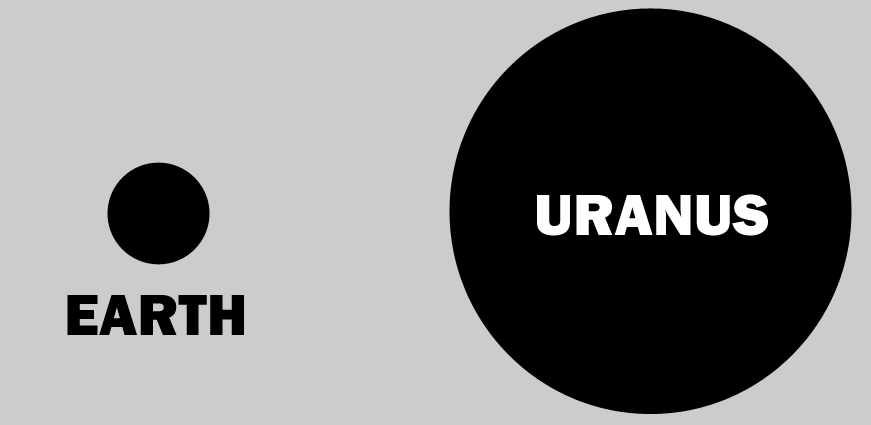URANUS
Earth - Uranus Size Comparison

- Uranus is the seventh planet from the sun and the third largest (by diameter). Uranus is larger in diameter but smaller in mass than Neptune.
- Uranus is the ancient Greek deity of the Heavens, the earliest supreme god. Uranus was the son and mate of Gaia, the father of Cronus (Saturn), and of the Cyclopes and Titans (predecessors of the Olympian gods).
- Uranus, the first planet discovered in modern times, was discovered by William Herschel while systematically searching the sky with his telescope on March 13, 1781. It had actually been seen many times before but ignored as simply another star (the earliest recorded sighting was in 1690 when John Flamsteed cataloged it as 34 Tauri). Herschel named it "the Georgium Sidus" (the Georgian Planet) in honor of his patron, the infamous (to Americans) King George III of England; others called it "Herschel." The name "Uranus" was first proposed by Bode in conformity with the other planetary names from classical mythology but didn't come into common use until 1850.
- Uranus has been visited by only one spacecraft, Voyager 2, on Jan. 24, 1986.
- Most of the planets spin on an axis nearly perpendicular to the plane of the ecliptic, but Uranus' axis is almost parallel to the ecliptic. At the time of the Voyager 2 passage, Uranus' south pole was pointed almost directly at the sun. This results in the odd fact that Uranus' polar regions receive more energy input from the sun than do its equatorial regions. Uranus is nevertheless hotter at its equator than at its poles. The mechanism underlying this is unknown.
- Actually, there's an ongoing battle over which of Uranus' poles is its north pole! Either its axial inclination is a bit over 90 degrees, and its rotation is direct; or it's a bit less than 90 degrees, and the rotation is retrograde. The problem is that you need to draw a dividing line "somewhere" because in a case like Venus, there is little dispute that the rotation is indeed retrograde (not a direct rotation with an inclination of nearly 180).
- Uranus is composed primarily of rock and various ices, with only about 15 percent hydrogen and a little helium (in contrast to Jupiter and Saturn, which are mostly hydrogen). Uranus and Neptune are in many ways similar to the cores of Jupiter and Saturn minus the massive liquid metallic hydrogen envelope. It appears that Uranus does not have a rocky core like Jupiter and Saturn but rather that its material is more or less uniformly distributed.
- Uranus' atmosphere is about 83 percent hydrogen, 15 percent helium and 2 percent methane.
- Like the other gas planets, Uranus has bands of clouds that blow around rapidly. But the clouds are extremely faint, visible only with radical image enhancement of the Voyager 2 pictures. Recent observations with HST show larger and more unced streaks. The speculation is that the difference is due to seasonal effects (the sun is now at a somewhat lower Uranian latitude which may cause more unced day/night effects).
- Uranus' blue color is the result of absorption of red light by methane in the upper atmosphere. There may be colored bands like Jupiter's, but they are hidden from view by the overlaying methane layer.
- Like the other gas planets, Uranus has rings. Like Jupiter's, they are very dark; but like Saturn's, they are composed of fairly large particles ranging up to 10 meters in diameter in addition to fine dust. There are 11 known rings, all very faint; the brightest is known as the Epsilon ring. The Uranian rings were the first to be discovered after Saturn's. This was of considerable importance since we now know that rings are a common feature of planets, not a peculiarity of Saturn alone.
- Voyager 2 discovered 10 small moons in addition to the five large ones already known. It is likely that there are several more tiny satellites within the rings.
- Uranus' magnetic field is odd in that it is not centered on the center of the planet and is tilted almost 60 degrees with respect to the axis of rotation. It is probably generated by motion at relatively shallow depths within Uranus.
- Uranus is sometimes just barely visible with the naked eye on a very clear night; it is fairly easy to spot with binoculars (if you know exactly where to look). A small astronomical telescope will show a small disk.
BACK
RETURN TO SOLAR SYSTEM